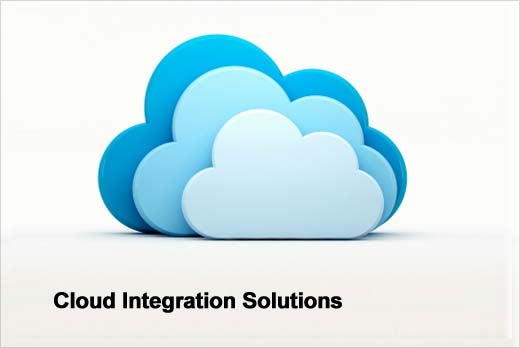
There are four basic options for solving cloud integration. Keep in mind that your cloud service provider may offer these options for free or as an add-on, but your organization can also handle the integration separately with a third-party provider or by building it yourself.
Click through for more on the four basic options available for solving cloud integration issues.
A significant number of SaaS integrations are still handled by point-to-point, custom written code. In fact, 40 percent of SaaS and cloud vendors develop point-to-point, custom integrations in house to connect to other applications and systems for their clients. If you have the skills in-house, you can also hand-code your own integration. Basically, the integration is accomplished by writing “calls” to the SaaS provider’s API, which will then send the data as a message.
You’ll probably be accessing the SaaS provider’s API, which will usually use protocols based on HTTP, REST, SOAP and JSON. Which languages you can use will vary by platform but, for instance, Java, .NET, PHP, Objective C, Ruby and Adobe Flex are among the languages Force.com supports.
- Most organizations feel they do not have the skills in-house to build custom code.
- It’s time consuming.
- Point-to-point integration can be easily broken if anything changes, and APIs do change. Ask your service provider about API updates. Be sure to attach service-level agreements so you won’t be caught disconnected. If you’re hand-coding multiple cloud integrations using API calls, consider investing in an API management tools.
- Custom integration does not scale well.
- API calls are not really designed to handle batch integration work. That’s more the domain of an ETL process.
- You may be able to find existing integration connectors that are maintained by someone else….keep reading for more on that option.
Think of connectors as out-of-the-box integration. Connectors are now offered for unstructured data such as video, images, audio, XML and geospatial data. Rebecca Wettemann, vice president at Nucleus Research, a research and advisory firm, estimates 80 percent of cloud integration can be handled with out-of-the-box integration.
There are too many vendors to list in this category, including many niche solution providers. Several integration vendors started out in cloud integration by offering connectors that ran on-premise. It tends to be more scalable, reusable and faster than custom code.
There are still on-premise options, but these days, most vendors now focus on connectors that run on their own cloud platforms. This type of solution is called integration-as-a-service or cloud-based integration.
On-premise connectors usually run on your servers as software. Many traditional middleware vendors now offer support for SaaS integration, including Informatica, IBM and Oracle. Other vendors include SnapLogic, MuleSoft and Dell Boomi.
IBM CastIron pioneered the appliance approach, packaging a number of SaaS integration connectors on an appliance, optimized for integration.
- These integrations can break, too, if, for instance, you change a business process that relies on the integration.
- Keep in mind that there may be an ongoing cost with these solutions, although, as IT solutions go, it’s generally affordable. SaaS vendors may charge for each time your connector accesses their service or for the data transferred. If ongoing costs are a concern, you might want to consider an appliance, which is a one-time cost, although it does require a yearly maintenance fee.
- Ask about scalability.
Note: Don’t confuse integration as a service with infrastructure as a service or Cloud-based integration vendors
These third-party solutions also rely on connectors, but instead of running on your infrastructure, the integration actually happens in the cloud. Like on-premise connectors, these “out of the box” integrations are more scalable, reusable and faster than custom code. They are also a great option for those trying to integrate multiple cloud solution, since all of the work is done in the cloud and the third-party vendor is responsible for maintaining the integration. This means if it breaks, you won’t be the one fixing it.
Traditional enterprise middleware vendors like IBM, Informatica, Oracle and Microsoft play in this space, as well as smaller companies such as Pervasive Software, Composite Software, Denodo Technologies, Jitterbit, Talend, Kapow, SnapLogic, Red Hat and Workday.
GetApp offers a list of additional providers in this space.
- The integration-as-a-service vendors run the integration off-premise. For some companies, this may raise questions about regulatory compliance.
- Like all services, the costs are ongoing and based on usage and volume. At some point, this may become a serious consideration, depending on how often you’ll access the data and how many SaaS services you’re integrating.
- This is a new market, so find out what happens if the company goes out of business or is acquired.
- Be sure to discuss service level agreements.
IPaaS solutions are development platforms that allow you to build your own integration for cloud to on-premise, cloud-to-cloud, B2B e-commerce, or even internally for your own cloud. They are used by cloud-based vendors and systems integrators, as well as midsize and large organizations. IPaaS addresses some of the shortcomings of other cloud integration solutions by offering a multi-tenant solution and support for design time and run-time governance.
It’s common for a SaaS provider to use iPaaS features in embedded integration or prepacked integration flows, either using its own or a third-party iPaaS solution.
Gartner sees iPaaS solutions fall into three categories of integration: e-commerce and B2B integration, cloud integration, and enterprise service bus (ESB) and service oriented architecture (SOA) infrastructure.
Vendors who offer iPaaS solutions include Ariba, D&B, eVariant, Intuit, Libra OnDemand, Mulesoft, Onventis, Oracle RightNow, Oracle Taleo, PeopleMatter, SuccessFactors, Workday, Xactly and Zuora.
- IPaaS is still in its infancy. That means it’s still not well defined as a solution category.
- Not all iPaaS are created equally. Ovum’s Saurabh Sharma points out that few iPaaS suites actually meet all of the complex integration requirements you need from an integration platform. For instance, not all are multi-tenant or can handle sudden surges in workload.
- Some SaaS and cloud vendors offer embedded integration using an iPaaS solution. That sounds great, but Gartner warns that the “growing availability of iPaaS as a cloud services embedded feature may lead to unproductive proliferation of integration capabilities, raising costs and increasing technical and governance complexity.”
















